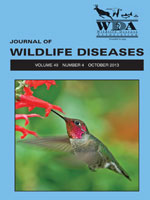Ranavirus (Iridoviridae) infection is a significant cause of mortality in amphibians. Detection of infected individuals, particularly carriers, is necessary to prevent and control outbreaks. Recently, the use of toe clips to detect ranavirus infection through PCR was proposed as an alternative to the more frequently used lethal liver sampling in green frogs (Rana [Lithobates] clamitans). We attempted reevaluate the use of toe clips, evaluate the potential use of blood onto filter paper and hepatic fine needle aspirates (FNAs) as further alternatives, and explore the adequacy of using green frogs as a target-sampling species when searching for ranavirus infection in the wild. Samples were obtained from 190 postmetamorphic (≥1-yr-old) green frogs from five ponds on Prince Edward Island (PEI), Canada. Three of the ponds had contemporary or recent tadpole mortalities due to Frog Virus 3 (FV3) ranavirus. PCR testing for ranavirus DNA was performed on 190 toe clips, 188 blood samples, 72 hepatic FNAs, and 72 liver tissue samples. Only two frogs were ranavirus-positive: liver and toe clip were positive in one, liver only was positive in the other; all blood and FNAs, including those from the two positive frogs, were negative. Results did not yield a definitive answer on the efficacy of testing each type of sample, but resemble what is found in salamanders infected with Ambystoma tigrinum (rana)virus. Findings indicate a low prevalence of FV3 in postmetamorphic green frogs on PEI (≤2.78%) and suggest that green frogs are poor reservoirs (carriers) for the virus.
How to translate text using browser tools
1 October 2013
LOW DETECTION OF RANAVIRUS DNA IN WILD POSTMETAMORPHIC GREEN FROGS, RANA (LITHOBATES) CLAMITANS, DESPITE PREVIOUS OR CONCURRENT TADPOLE MORTALITY
María J. Forzán,
John Wood
ACCESS THE FULL ARTICLE

Journal of Wildlife Diseases
Vol. 49 • No. 4
October 2013
Vol. 49 • No. 4
October 2013




